In a time long past, when foreigners roamed the Korean scene, and Zerg was not felt, but known to be underpowered, there rose a champion that changed the way we thought about the race. We’re going to scrutinize FruitDealer’s play and ask, with the benefit of hindsight, why the man who took a broken race to tournament victory, the first such victory for Zerg, never managed it again.
First, anyone analyzing
It’s also worth noting the maps were, and we’re being kind here, unrefined. The maps for that first GSL were Blizzard’s ladder maps, including such unforgettable (try as we might) gems as
It was a young game, and one whose balance was stacked against FruitDealer [AKA Cool], who was playing the weakest and most underrepresented race in the tournament (there were sixteen Zergs in the round of 64). It seems reasonable to pose the question, how did he beat the odds?
There was one strategic and several tactical elements that defined his play, but it all boils down to the fact that FruitDealer took risks that his opponents couldn’t respond to, or failed to scout in time. He used those risks to obtain monumental advantages, rendering questions of balance irrelevant. While his micro was superb for the time, and allowed him to execute these builds, it was gutsy moves like going up to 70 drones with two zerglings, or going for a one-base nydus against a Terran, that gave him a vital edge.
When play like this failed he looked ridiculous, but when it worked he looked untouchable. These are the hallmarks of innovative, high-risk players; they either crush or are crushed. There is no middle ground. From the above, you’d be forgiven for thinking that FruitDealer just rolled the dice in every game he played, but rolling the dice can go a long way when you’re using loaded dice.
![[image loading]](/staff/shiroiusagi/fruitdealer/fd_thegambler.jpg)
Some men are born lucky and, from the day of their birth, will never know adversity. Other men are cursed, damned never to rest, nor know comfort and security. Still others are fated for something greater, driven to some lofty goal. These are the kinds of people who, regardless of their background, forge their own destiny, their own brand of luck. It’s that special brand of luck that’s the end result of blood, sweat, and tears.
FruitDealer fits firmly in that last camp, a gambler in a wild and untamed space making his own luck. In order to understand what, at the time, often looked like remarkable fortune, we should examine FruitDealer's overall strategic style, the style that defined him as a player, and the key elements that allowed him to strangle his opponents.
The truth is that FruitDealer played with touch-and-go strategies, but it’s important to keep in mind the dominant styles of the time; the typical Terran play against Zerg was to harass them to death. This meant endless rounds of hellions, banshees, and reapers, with marine/tank pushes if the battered Zerg managed to limp out of the early game.
The dominant Protoss strategies against Zerg were also one-base plays, with the four-gate being the most common. Against these, Cool had two distinct approaches, the hyper-aggressive cheese, and what came to be known as the "eco cheese.”
Hyper-aggression
His particular brand of hyper-aggression found success because FruitDealer's opponents went into games knowing how they would play. Nobody had figured out the correct reactions to insane, all-in builds. This was a consequence of the game’s youth; players at the time had only played a few hundred games, they were still at the stage where sticking to a build would earn more wins than losses, at least against lesser players.
For example’s sake, consider game one of the GSL round of eight match between oGs_Inca and our favourite greengrocer, on
Six pooling today is just shy of suicide against any competent player, especially on a large map, yet somehow Inca lost. The truth is that the impracticality of it is a big part of the reason for his success; it was the last thing Inca expected. In FruitDealer's previous ZvP series’ he had never gone for any build that wasn't economic or defensive. The "cheesiest" we'd seen from him (also on Kulas Ravine) was a twelve gas speedling-expand to the gold.
The second factor in ensuring Inca's downfall was that he either panicked or just didn't know how to react. Inca first failed to wall off when he saw the lings inbound, and then pulled all of his probes to defend, rather than leaving enough mining to still be able to build zealots. He was left with one zealot, a dozen probes, and no minerals. Throw in some superb micro from FD and there was no way for Inca to win. Had Inca either completed his wall or not overreacted, it would have been over for FD.
The second game was just as aggressive; FruitDealer opened with what looked like an econ-build, with a fast-expand before pool against a two-gate from Inca. He held the two-gate with minimal losses, but then threw down a baneling nest in response to Inca’s attempt to expand behind cannons. Inca discovered too late that, instead of droning desperately, FruitDealer would send wave after wave of banelings and zerglings at his base. Inca lost several buildings, a raft of probes, and an expansion. The game dragged out another few minutes, but the outcome had been determined by the time a swarm of roaches ended it.
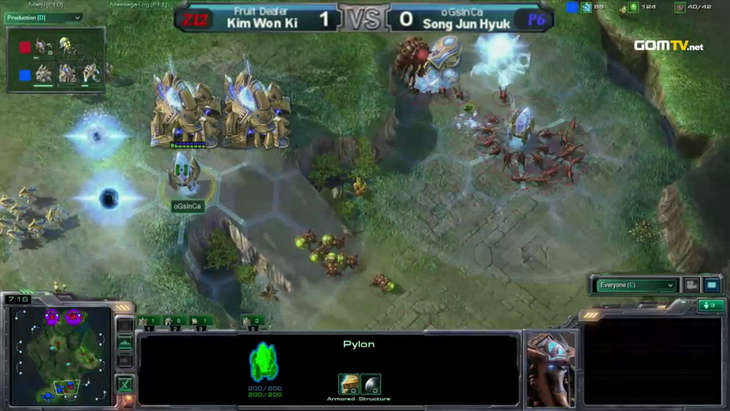
Inca realizes that those are, in fact, not drones.
None of the games lasted longer than fifteen minutes. The key point is that all of the games in this series were based on screwing with his opponent’s perceptions of what was happening. In game one, FruitDealer gambled on Inca not knowing how to react, being prepared for something different, and the dice favored the Zerg primarch.
Game two, however, was based on exploiting what Inca thought FD’s reaction to two-gate pressure would be and doing the exact opposite. Because Inca wasn't prepared for this reaction, he had hardly any units, and lost there and then. This series illustrates just how few assumptions players facing FD could afford to make.
That said, the insane builds didn't always pay off. One shining example came in the case of game two of FruitDealer versus TOP in the round of sixteen, on Lost Temple. FD had secured a win with an economic gamble in game one (the infamous 70 drones with only two zerglings), and his opponent had been left off balance. This is the exact of moment at which Cool loved to pull the hyper-aggressive builds. He went one base lair, upgrading zergling speed. He then built a bunch of lings, throwing down a nydus network.
Here he made a critical error; he allowed his lack of expansion and fast lair to be scouted. While TOP had no way of knowing quite what was happening, he knew something odd was coming his way. Unlike Inca later, he kept his cool. He prepared for any possibility, pumping out marines (in case of a one base muta build), hellions (because he knew there were fast zerglings) and vikings (because he had a starport, and when being all-inned every unit counts). Then, he huddled in his base.
He knew that all he had to do was stop the all-in. For a moment, it looked like FD might have had it anyway, but it turned out that being scouted and giving his enemy enough time to prepare allowed TOP to secure victory. The risk had left FD one game from elimination.
Still, these builds, even when they failed served their purpose; opponents were scared into tentative, safe play. The end result was that, when Cool decided to go for risky economy-centric builds, he would be safer than any other player in the same position. His opponent had to be consistent in their scouting and prepared for him to suddenly go all-in, which meant they couldn't stop him from droning like a madman, gaining an insurmountable advantage.
Hyper-economic
We've already seen what happened in game two with that failed nydus worm rush, but let’s take a look at game one, on the now defunct
Seeing banshees, he built more drones. As his spire finished, he picked up a third. After all, seven mutalisks should be more than enough to defeat any reasonable Terran push. Protected by an anaemic nine mutalisk flock, FD decided to build more drones, and grab as much tech as he can afford (which, with only nine mutas, is quite a bit).
At this stage, TOP had two or three thors, a few siege tanks, and a handful of marines... all arrayed against nine mutalisks and two zerglings. All TOP had to do to roll over FD was push, yet he was pinned down by those nine mutas. Sitting at 80 drones and grabbing a fourth at the gold, FD decided that the time was right to start making offensive units.
His army bloated into something worth worrying about, a storm of mutalisks, banelings, and zerglings, with a handful of roaches for good measure. TOP had to get aggressive; he had gone from watching a passive Zerg, to seeing flocks of mutalisks and swarms of Zerglings darting across the map, wreaking havoc. The game ended when FD lost his army twice, took it in his stride, and then made fifteen ultralisks at once.
That’s easy to understate, but he made fifteen ultralisks and rolled over the shattered remnant of the Terran army. By that point, Cool couldn’t have cared less about "trading economically" or "unit retention," he could roll over TOP just by throwing minerals and gas at him, resources stockpiled by virtue of not having made any units until fifteen minutes into the game.
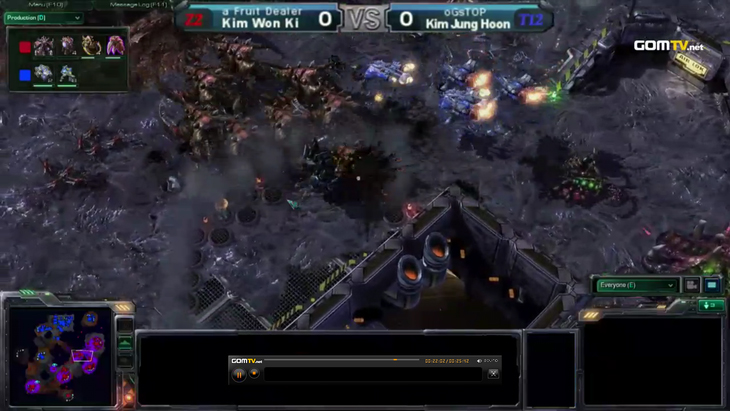
Marines are imbalanced you say? That's nice.
That goes some way toward explaining the logic behind that nydus worm. TOP would have been gearing up for some intense midgame aggression (it looked as though he was preparing some hellion drops), to prevent the same scenario unfolding all over again. As a result, that early cheese, intended to catch TOP off guard, seemed like a winning proposition.
Of course, we all know how well that worked out for FD. This set the stage for a third game on
FD built drones, an enormity of drones. TOP went hellion/banshee and FD built four roaches, and more drones. TOP transitioned into Thors, more hellions, and an expansion. FD built more drones, eight of them at the time; TOP couldn’t kill them quickly enough. A banshee picked off his queens, so FD grabbed the gold, teched, and built drones. There were four thors out, a bunch of marines, and the Terran was setting up a planetary fortress at the gold. FD picked up a fourth, and built more drones.
When he hit 60 drones, things changed. He could afford to build a few units, morph zerglings and banelings, drop them in the Terran main, and then get another fifteen drones. Somewhere in this match, he had gone from being down against a harassing Terran on an imbalanced map to having the advantage. Sure TOP has 200/200 thors, but he had an ultralisk cavern, and resources enough to pump out so many ultralisks it was hard to know what could possibly oppose Fruitdealer
In this position, it would be easy to let things start to slip. Instead, he took a fifth base. Sure, to the untrained eye the twelve thors barrelling toward the main seemed threatening, but he had an army and all those resources are burning a hole in his pocket. He had to lose that army so he could make another, and then another, like waves against a cliff to erode the Terran. It helped that ultralisks dealt splash damage to the Thors and cut through them like an axe through so much soggy cardboard.
This is how FruitDealer went into the game, and it dragged a little after he took out those Thors; after all, planetary fortresses are tough, but he had all those drones... TOP tapped out.
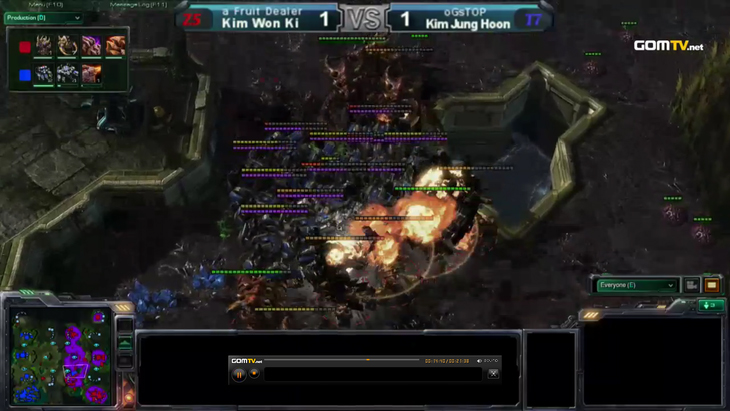
I have drones. Ultralisks too.
We could study more of FruitDealer’s games in which he crushed Terrans by overrunning them with sheer weight of resources, but the majority of them followed a similar pattern. The idea behind these "eco cheese" builds was simple; build an enormous number of drones, and keep your opponent pinned down.
When Cool lost drones, he just made more. He didn't care if he lost ten drones to a banshee; he’d make 25 more. It wasn’t until he was comfortably sitting at 60-70 drones and at least three bases that he got any kind of useful army.
This is the kind of luck that FruitDealer gambled on; it’s easy to beat the odds when you’re stacking the deck.
![[image loading]](/staff/shiroiusagi/fruitdealer/fd_thescholar.jpg)
If, with the strategies described above, FruitDealer managed to wrestle luck itself to his side, then it was with his shrewd tactics that he ensured his opponents couldn’t manage the same.
The Pin
By now, you should be aware that many of FD's hyper-economic builds relied on his not being attacked while he built up that critical mass of drones. One way he accomplished this was by using highly mobile units to keep his opponent in his base. Above, FD managed to keep a terrifying Terran army at bay using only nine mutalisks. He crucified his opponent in his own base, forced to keep everything at home to stop a few mutas picking at his workers.
Part of the reason this worked is because of the midgame timing of the pin; FD tended to time his harassment so it would hit just as the Terran prepared a push. This coincided neatly with his nearing 60 drones, which meant he could afford to be reckless. He would engage turrets and groups of marines with mutas, sometimes flying into range of thors.
As long as he could keep the Terran at home, he could afford to keep replenishing that stack of mutalisks and take a fourth base. Through most of the games the FD went for mutas, he neither upgraded nor overproduced. Instead, he capped himself around twelve; they weren’t meant to be the backbone of an army, they were never going to win any battles for him, not directly. They existed to pin the Terran back, winning the game by forcing opponents into inactivity.
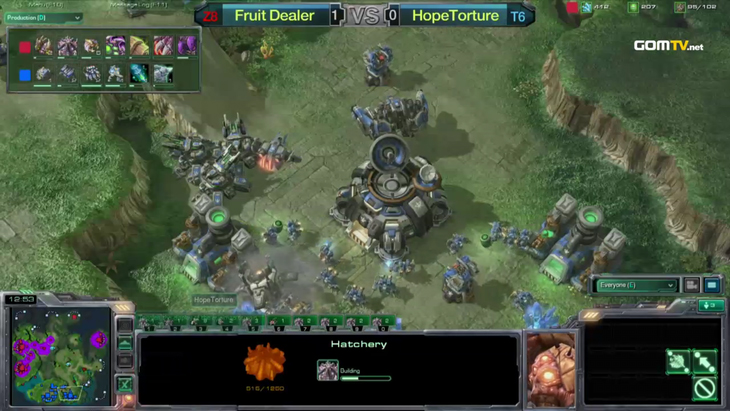
Two lings and nine mutas, are not *quite* enough to stop two thors, three siege tanks, and a couple of handfuls of marines. Of course, they don't have to be...
Mutalisks weren’t the only unit to keep opponents at home, although they were the unit he employed most often. As we saw in game three of FD vs. TOP he also used overlord drops, usually zerglings when hitting bases, and banelings when hitting mineral lines, to force the Terran army to stay home to protect SCVs and production facilities while FD happily built drones, protected by the paper tiger of his aggression.
The concept was simple; with a smaller, more fragile, and more mobile army, he'd keep the Terran running around the map, trying to stymie assaults before all the SCVs and production facilities were lost.
Moreover, the pin afforded him awareness of everything his opponent was doing. The flocks of mutalisks, overlord drops, and nydus worms gave him the additional information he needed to be able to react early. If he saw marines pumping out of fifteen rax, he could build an appropriate number of banelings. If he saw masses of thors, he started gearing up for ultralisks.
The timing of the pin was such that it usually hit while he took his third base. As a result, FD was hitting 60 or so drones, the "critical mass" of resource collection to react to almost anything. It became the magic number at which FD hit his stride and became invincible, and the pin was what empowered it.
The Prod
The Prod is an early game technique present in almost all of FriutDealer's matches. The concept is simple; you push out with a handful of units, early in the game, in an effort to put your opponent under pressure, but also to see what he’s doing. What’s curious about Cool's method of prodding his opponent is that it seems always to be a response to his opponent’s opening.
FruitDealer didn’t often build units with which to prod, but used units that he had made in reaction to his opponent instead. If you take into account his overall strategic philosophy (those hyper-economic builds), this seems straightforward. Those larvae and resources weren’t spent on drones; they must be used to delay the enemy, to get maximum mileage out of those resources, to secure more drones.
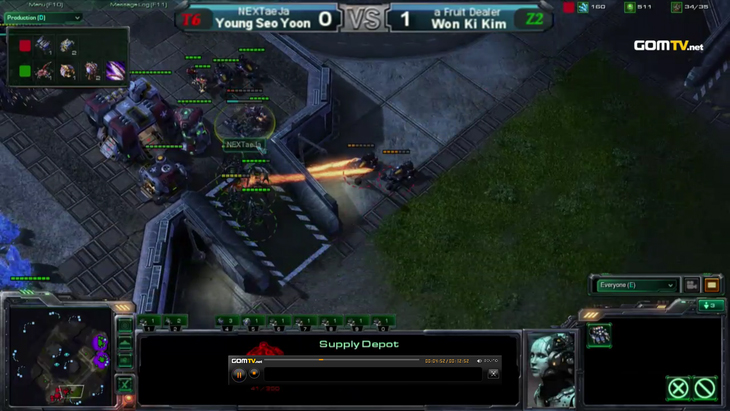
Poke!
One great example of the potential gains of a prod comes from game one of FruitDealer vs. TaeJa, in which FruitDealer made four roaches in response to hellions. As soon as he had fended off the hellions, they scuttled across the map to attack the Terran front. This had three effects.
- It let him know what is going on. In this game, the roaches were repelled by hellions and marines, informing FruitDealer he had nothing to worry about. In another game (game one of FruitDealer vs. LiveForever) he saw marauders, and responded with a swarm of Zerglings.
- It put pressure on the opponent. If he were unprepared, it would allow FD to deal damage (snipe tech labs, kill hellions, etc.). This is important because, at the time, Terrans yet to develop strong transitions; the time between hellions and, for example, banshees, left the terran vulnerable.
- It helped to pin the Terran at home. In the game we’ve been looking at, it forced TaeJa to waste hellions microing around roaches, trying to stop them from wreaking havoc in his main, leaving drones mining unmolested in FruitDealer's base. By the time TaeJa had dealt with the roaches, defences were in place to deal with the hellions.
This early game prod is essential to understanding FruitDealer's reactionary style; it gave him enough information on his opponent to make informed decisions on whether he had to get anything other than drones, and bought him the time to buy an army should he need it.
The Counter Attack
In many ways this is a natural extension of the prod; if you’ve been forced to make units to defend, you might as well fling them at your opponent.
Perhaps the clearest example of this comes in the first game of FruitDealer’s set against GuineaPig. Having beaten back the four-gate, FruitDealer retaliates, taking all of his units (mostly zerglings) and throwing them at his opponent.
Often, FruitDealer would combine this with either a nydus worm (as in game three against LiveForever) or an overlord drop (as in game three against TOP). Occasionally, this counter attack would develop into a pin. With the overlord drop in his third game against TOP, it could be argued that the units he used to pin down TOP, keeping the Thor attack at bay, were made to defend, and that the units were really being used as part of a counter attack, rather than to pin.
It can be difficult to distinguish between pinning and counterattacking sometimes. Counter attacks have the benefit of forcing your opponent to react or base trade (and at this point of the game, most opponents were very uncomfortable with the idea of base trading, even with floating buildings). Counter attacks don't exist to force a response; they aim to deal damage. As an added bonus, they force the opponent to do something about it.
In combination, these tactics serve a single purpose. They allowed FruitDealer to take what looked to be insane risks, building drones almost exclusively (and getting as much value out of non-drone units he has to build). Of course, this is only part of the reason FruitDealer was successful, he also innovated in ways that put him ahead of other Zerg players.
![[image loading]](/staff/shiroiusagi/fruitdealer/fd_theinnovator.jpg)
![[image loading]](/staff/shiroiusagi/fruitdealer/fd_08image.jpg)
Cool, a FruitDealer
Every little edge, every unexpected trick can mean a sudden and crushing victory over an unsuspecting opponent. It is important to understand that the process of outthinking an opponent begins before the game itself; with this understood, we begin to see some of the ways in which FruitDealer eked out those victories.
The Strength of the Queen
![[image loading]](/staff/shiroiusagi/fruitdealer/fd_09image.png)
*Insert cheesy fruit related pun about queens and drones*
![[image loading]](/staff/shiroiusagi/fruitdealer/fd_09image.png)
*Insert cheesy fruit related pun about queens and drones*
I’d be remiss if I neglect to mention the queen, even though FruitDealer's use of it was no radical departure from that of other players of the time. The queen was almost as important to FruitDealer as his drones, and his early game defense hinged on them. It was the strength of queens defending against hellions, reapers, and particularly banshees that allowed FruitDealer to drone so heavily. However, it wasn't the realization that the queen was a powerful defensive unit that made FruitDealer's use of them outstanding. It was his understanding of the power of transfuse that made it a notable unit in FruitDealer's arsenal.
FruitDealer was effectively the first Zerg to use the queen as more than just an early game defensive unit and a larva spawner. He thrust an active role upon the queen, having it dole out health. It’s because FruitDealer relied on so few units that he came to rely so heavily on transfuse. After all, when you only have nine mutalisks, the difference between 1hp and 120hp starts to seem significant. His use of transfuse on spine crawlers in the finals, as well as healing of mutalisks mid-battle against LiveForever, brought to light the fact that FD understood the power and versatility of this ability in both defense and offense.
This was nothing profound, though it probably won him the second game of the finals. It’s hard to judge how critical it really was, but it shows the kind of attention to detail and keenness to maximize resources that give an excellent perspective on what made FruitDealer such a scary player.
The Power of the Baneling
Back in that first GSL, banelings seemed to serve as the backbone of just about every Zerg army. FruitDealer didn’t invent banelings, nor did he invent the infamous "run an infinite number of banelings into marines with siege tanks and hope for the best" strategy. The majority of FruitDealer's baneling micro was less than stellar, the truth is that by GSL2 it was subpar. This was probably forgivable, given that marine splitting hadn't been invented yet, but Foxer (or MKP as he would come to be known) would make him pay bitterly for that lack of control.
All you need to know is this:
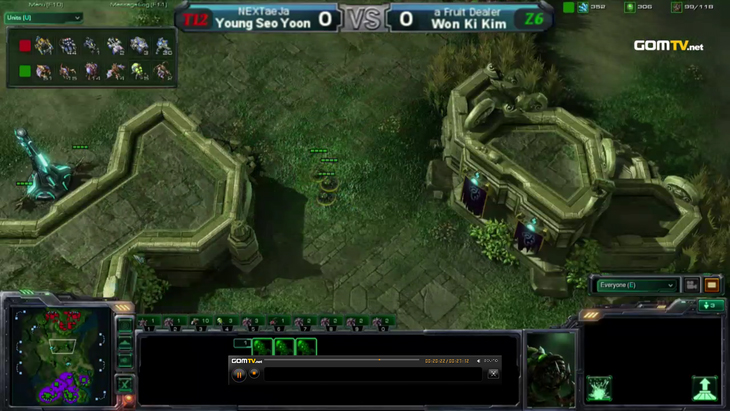
This!
FruitDealer pioneered burrowed banelings and, though he found little success with them, it was his use of burrow as a delaying tactic that stands out. Again, this was not a crucial discovery; it was just one more facet of his play that elevated him above other Zergs of the time. It’s a testament to his foresight that burrowed baneling play is even now becoming more popular. Burrowing banelings bought FD more time, and forced his opponent to waste time waiting for energy to build up on their orbitals.
After all, time is drones.
The overlord is perhaps the most boring unit in the game, valuable only for scouting, becoming overseers, and inching away from marines while making funny noises... except for FruitDealer. Instead, he chose to see overlords as a weapon zerg players would just happen to have lying around in every game.
Using overlords to scout was hardly a new concept, but FruitDealer excelled at it. For his time, he had the best placement going, covering the map with overlords so he could track his opponents’ movements. Because he relied on knowing what was coming, this intelligence would prove invaluable, and well worth the couple of overlords that met their untimely demise as a result. That said, what most distinguished FruitDealer's use of overlords was his understanding that overlord speed and drop are invaluable upgrades.
FruitDealer was more than happy to pay 300/300 in order to drop whole armies into his opponent’s main, pulling out again before they could react. This is a logical extension of the playstyle we’ve described until now.
He made few units, so he had to maximize their mobility. What is noteworthy is his use of overlords as a delivery system for banelings. By using overlords to drop banelings, he did two things. First, he surprised unsuspecting enemies more worried about the incoming zerglings and mutalisks than a cloud of overlords. Second, he remedied his lackluster baneling micro by not having to micro them at all. Having overlord drops allowed him to pin his enemy by dropping banelings into mineral lines and zerglings into bases, lending him additional means by which to counter attack.
Using overlords as yet another weapon gave FD an edge over other, less innovative Zergs, and allowed him to implement his tactics in new ways.
The Potential of Fungal Growth
It's important to realize that the modern fungal growth and the fungal growth that FruitDealer used are different beasts. The fungals that FD used dealt next to no damage, instead rooting enemies for eight seconds. Combined with banelings, this proved deadly, but even without banelings it suited FruitDealer’s style. It provided an instant stall, which played to FD’s strengths.
To understand FD’s application of fungal growth, watch the fourth game of the finals, FD vs. HopeTorture (now StartaleRainbow), in which he opted for a midgame infestor build, rather than the more common mutalisks. The goal was the same as the muta build’s – trap the opponent. Rather than pinning with harassment, do so with spells.
Even though the build failed (it would be the only game FD dropped in the finals, and the second in his whole GSL run), it’s a clear precursor to future infestor-heavy builds, though they would drop the hydralisks in favor of more infestors. The only major oversight was that he failed realize the destructive potential of infested terrans, likely because he saw the infestor as means to buy time, rather than an aggressive unit.
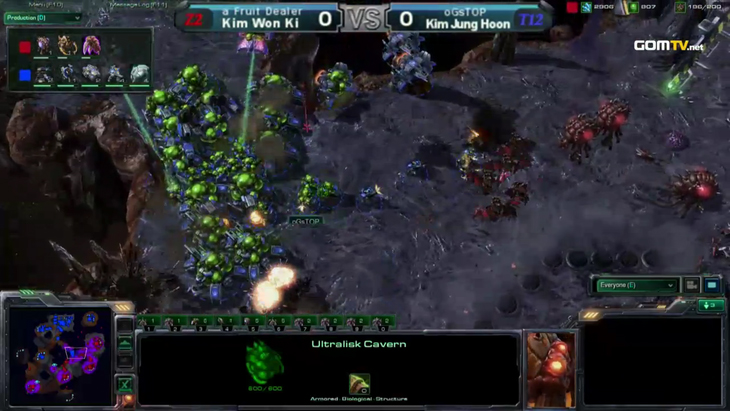
Fungal Everything.
Even if he hadn't pinpointed the full potential of infestors, his use of them was still better than that of other Zergs, if only because it served a definite purpose. In the above screenshot (from Game 1 vs. TOP), the fungal is both pinning the units in place for the banelings to drop and, buying time for eleven ultralisks to pop so that they can ravage whatever survives.
All of this leads us to his signature, the unit that defines his play…
Power Overwhelming, the Ultralisk
![[image loading]](/staff/shiroiusagi/fruitdealer/fd_13image.jpg)
A dozen Appleisks please.
![[image loading]](/staff/shiroiusagi/fruitdealer/fd_13image.jpg)
A dozen Appleisks please.
This is the unit around which his whole gameplan evolved, the bludgeoner, demolisher of tank lines. It is important to note that, while FD was using ultralisks, they took a long time to build, so buying time for them to pop was still a serious concern once the cavern was up.
The reason why ultralisks were so well suited to FruitDealer’s strategy, and the reason he was the only Zerg to use them, was that the ultralisk was an excellent unit against mech compositions, as well as bio-mech compositions without marauders. That is, of course, assuming you have enough funds to build a lot of them and overrun tank lines. Since ultralisks handle tanks so well, they were ideal to combat turtling Terran players. The Ultralisk’s splash damage also made it the ideal counter to the masses of thors that Terrans so loved to build.
The only composition that ultralisks in the numbers that FruitDealer built them would have had trouble with was marauder heavy builds. Since he seldom bought roaches after his opponents were done with hellions, Terrans very seldom built marauders. This proved unpleasant when the ultralisks arrived, as Terrans found that their planetary fortresses, thors, and tanks were insufficient defense.
It would be dishonest to omit the fact that the Ultralisks of the time we’re describing were better than the Ultralisks he and other Zerg players would have access to later. In patch 1.1.0, ultralisk splash was increased and the way it worked was altered. In that patch, splash was determined from the center of the unit targeted, and covered an area of the radius of the unit +2. This meant that ultralisks absolutely wrecked anything that was at all clumped. Mass thors (such as the huge clump of thors in game three vs. TOP) were annihilated by ultralisks. This also made ultralisks effective against planetary fortresses, as they slaughtered repairing SCVs in seconds. In patch 1.1.1 this was fixed, but while it lasted it rendered FD's ultralisks almost unstoppable.
By now, you’ll have realized that FruitDealer favored two types of units exclusively until he got Ultralisks, units that augmented his mobility (mutalisks, zerglings, overlord drops, nydus worms) to pin his enemies, and units that allowed him to slow the enemy advance down (burrowed banelings, fungal growth, transfuse). FruitDealer's entire game centered on obtaining an overwhelming advantage and forcing the issue with ultralisks.
![[image loading]](http://www.teamliquid.net/staff/shiroiusagi/fruitdealer/fd_thewarrior.jpg)
![[image loading]](/staff/shiroiusagi/fruitdealer/fd_14image.jpg)
The best series of GSL 1
Watch along with the best series from that first GSL: here.
Game 1
Now, let’s begin by analyzing that first game on
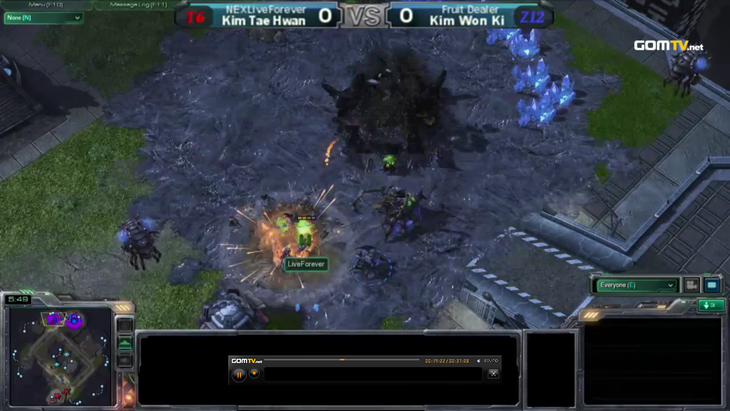
Not a good place to be
Things looked dire for FD. Despite getting four roaches out he lost the hatchery. Most Zergs would GG around there, but not FruitDealer. He stays calm, and does what he does best; he re-expands without dropping a beat, then he keeps building drones. He now has four roaches, what does a FruitDealer do with defensive units he no longer needs?
He lost all four roaches in exchange for a handful of marines, but managed to spot a Starport, warning him that LiveForever is going for banshees. In response, he started his lair and threw out fourteen lings, catching a lone hellion. FruitDealer lost eight drones to a banshee before his overseer finished, but remained ahead with 40 drones, and more morphing.
LiveForever expanded, prompting FD to grab a third base. He also saw the incoming timing attack and planted three spines at his second base, then poked in again, killing a few marines and forcing LiveForever to pull away, buying time for those spines to finish and meet the attack.
This attack was mostly marauders and marines, which tore down the third, while FD's mutalisks cut off reinforcements. This caused Live to stop reinforcing the army, which, after taking down the third and not much else, was cut off and facing about twelve mutalisks. It should have been an even battle, so LiveForever's marines stayed to fight. Unfortunately, FD knew a trick most didn't and transfused the mutalisk being focus-fired three times. The army that had taken down the third had evaporated and all it had cost was a drone to build the third, a handful of lings, and two mutas.
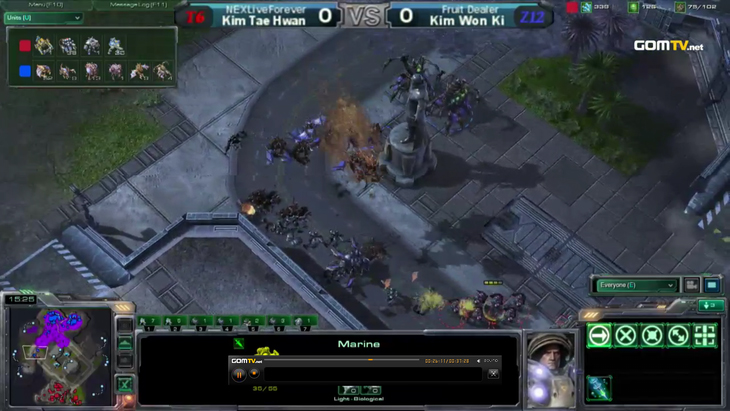
Transfusing Mid-battle.
Incensed, Live pushed out with his remaining forces; two dozen marines and a thor. A cloud of mutalisks flew by the army, spotting it and heading toward the natural. FD sat comfortably at that perfect sixty drones, and threw up two more expansions. The force pushing out had been drawn home by the threat of mutas, but was on the move once more, bolstered by more marines.
The back-and-forth had bought enough time to hatch zerglings, and morph about half of them into banelings, simultaneously picking up roach speed, infestor tech, and baneling speed. The time it takes for the attack to arrive was enough to gather his forces, and quash the attack. FruitDealer, no longer on the back foot, was up four bases to two, an imposing army to the Terran's dozen marines, and he looked like he was about to wreck his opponent.
LiveForever tried hard to make drops work, but he was consistently thwarted, the hive almost up. The game was effectively over, an ultralisk cavern under construction. LiveForever moved out in desperation, a few tanks, thors, and plenty of marines. He needed to hit before ultralisks hatched. However, FD knew just how to play it.
He fungalled, waited for the army to advance, and then fungalled again miring what should have been a lightning push across the map. The ultralisks hatched in time and, in heartbeats, the army was erased.
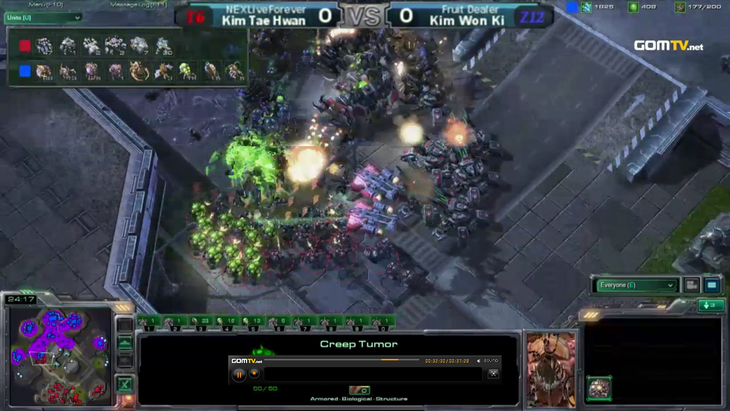
Gone in ten seconds
The game was over, 81 supply to 200. The Terran had lost. Sure, it took a couple of minutes for FruitDealer to end it with a nydus in the main and the destruction of the planetary fortress at the third, but it had been over already. LiveForever GGed.
FruitDealer centered himself, preparing for game two.
Game 2
FruitDealer had the initiative going into game two. He's just crushed his opponent from a position from which no Zerg could be expected to recover; this would be an ideal time for a hyper-aggressive build, and there is no doubt that LiveForever had that at the forefront of his mind. Game two was on
Defying expectation FruitDealer opened with a fourteen hatchery, slightly delayed by LiveForever's harassing SCV, which threw down an engineering bay. FD's overlord scouted LiveForever going for reactor hellions and he dropped a roach warren. FruitDealer made three roaches and tossed them at LiveForever, forcing the hellions to waste time trying to slow them.
The three roaches were met by another three before attempting to storm the Terran main. LiveForever pulled SCVs to defend behind two bunkers. FD lost a few more drones to hellions and his pressure was deflected. At the cost of four drones, he stopped the harassment. Afterward, he poked with a few roaches, as a single viking chased down overlords.
By now FruitDealer's plan was on track; mutas came out as built his third. The mutas harassed, picking off a few SCVs. They also scouted marines and thor production. As the third went up he added a baneling nest. Having seen the marines and the thor FruitDealer made around eight banelings. The banelings burrowed in two groups outside the terran expansion.
As Live moved out he scanned and eliminated them, moving to take down the rocks at the middle bridge to attack. FruitDealer responded with the pin. He sent his zerglings to the Terran main, forcing the Terran home. Then he burrowed the zerglings and waited for an opportunity to backstab. The Terran, having dealt with the situation in his base, pushed at the bridge, but it had been too long. FD had reached his 60 drones on two bases, he had started building infestors, banelings, and zerglings. FruitDealer had known what was coming and he was more than prepared to handle it as he planted his fourth at the gold.
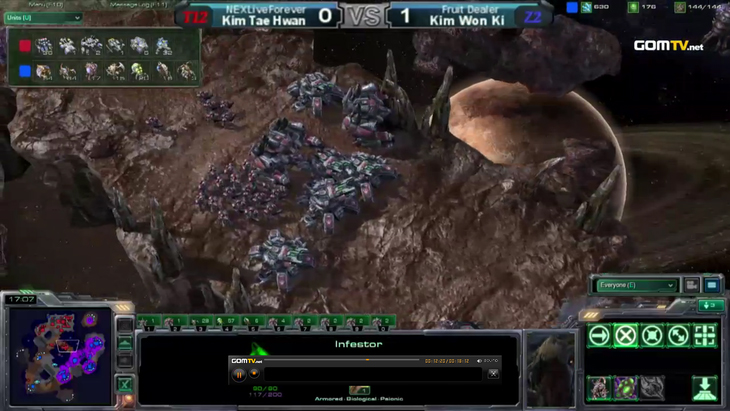
Any guesses as to what is going to happen to this army?
While the army postured, Cool feigned an attack towards the main on the left side of the map with lings and roaches. Again, the Terran was forced back in a desperate bid to defend. The mass of units that had been waiting for the Terran push had an unseiged target to hit. As LiveForever pulled away, banelings rained down on his now fungalled army and a tide of lings washed in.
The army evaporated, all that remained were dozens of zerglings, roaches, and infestors right outside an unprotected Terran base.
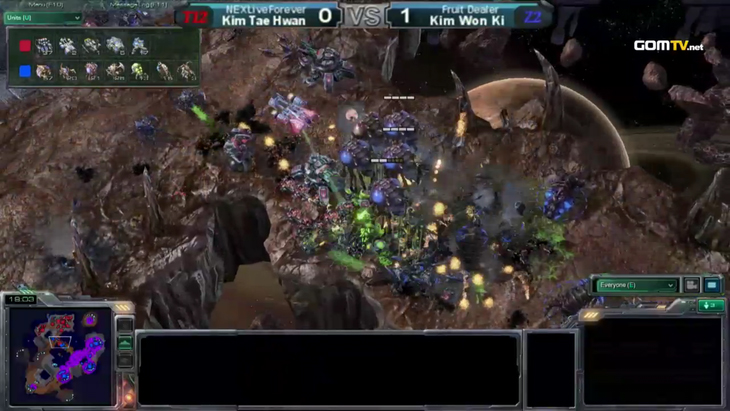
If you guessed "die horribly", you win
At this point FruitDealer didn't need to wait for ultralisks. He pushed with roaches and the Terran base folded. The base was gone, Terran hopes following close behind.
Game 3
LiveForever was on the ropes, helpless in the face of FD. He'd lost two games and only had one more to lose to end it all. He'd been at an incredible advantage, but never quite enough. He needed to figure something out fast.
Figuring things out requires time, so FD opted for cheese. This was, after all, his favorite time to cheese, when he had a significant advantage, with an opponent off balance. The game was on
FruitDealer opened with a thirteen gas, fourteen pool, with no expansion in sight. LiveForever suspected nothing, in fact his SCV scout was running late and hadn't found FD's base yet. LiveForever started his reactor-hellions, while FD's roach warren came up, and a scouting overlord caught sight of the factory and reactor. Two hellions emerged as roaches poked towards LiveForever's base, forcing him to fall back, without scouting that FD is on one base. However, he'd grown cautious since last game.
He already had two bunkers with marauders and concussive shells on the way. Eventually, the hellions made it to the main. Live probably assumed that FD had expanded to the gold, his usual play on this map. With two hellions scouting the map, frantically looking for a base that doesn't exist, FD’s spire started to morph.
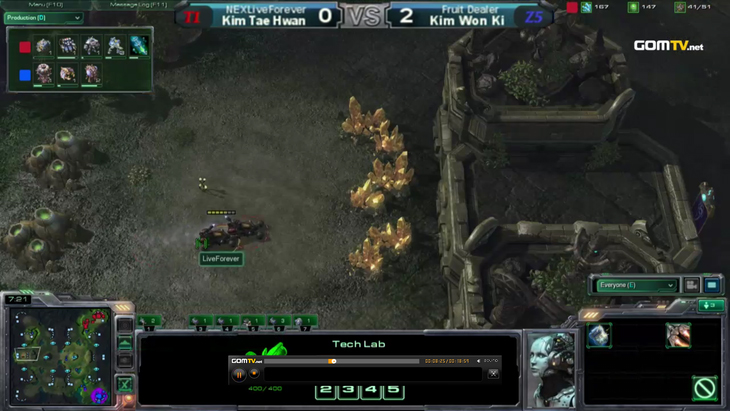
Nothing there Jimmy
LiveForever got suspicious as the spire was constructed, adding three more barracks. If some kind of nydus or roach all-in was coming, he’d need to have something to stop it. Stim finished as the first four mutalisks popped in FD’s base. Given the number of marines, this one-base gambit seemed to have failed already. Undeterred, FruitDealer threw down a hidden expansion, sent his four mutalisks in, and hunted down the last remaining hellion with his roaches, ensuring the secret base wouldn't be spotted.
The mutalisks spotted the marines and backed off as LiveForever’s turret construction began. It seemed like LiveForever had learned his lesson about being pinned; the moment the turrets were done he sent his whole army towards the Zerg main. He wasn't going to let mutas hold him at home while FD grabbed bases and droned up. No, he would run over the Zerg. FruitDealer could rest assured, had the Terran held on and killed his army, he would truly have had no chance. Instead, it had become a base trade, a coin-flip, and FruitDealer had a habit of winning coin flips.
FruitDealer started four spine crawlers and threw everything he had at the Terran main. Four mutas, about sixteen zerglings, and six roaches tore through the rax as the Terran army arrived at a deserted Zerg natural. FruitDealer tried to smuggle out some drones, only to have them torn to shreds by marines and marauders.
Meanwhile, every SCV in LiveForever's base had been eradicated, and buildings were burning. FD had gone up to eight mutas, an additional four having hatched in his secret base with hoarded funds. LiveForever overstimmed, and his units, in their frenzy to kill the entire Zerg base, were at death’s door. When the mutalisks swept in, the fight was brief. That untouchable Terran army had defeated itself, the secret base unscouted.
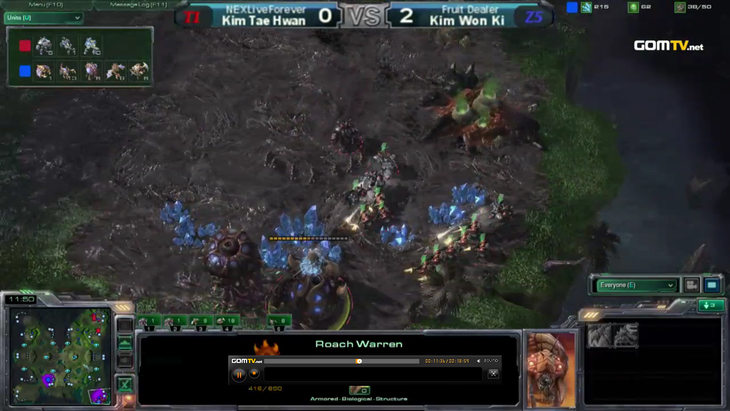
The fatal stim
With no units left and his base in flames a frustrated LiveForever had no choice but to GG, closing the best series of GSL 1, a series far superior to the finals, one in which the Terran refused to let FruitDealer play his own way, and in which FruitDealer did anyway. This series showcased FruitDealer's ability to delay, the power of his economy, and his skill in handling base trades.
The sad truth was that it was no surprise when FruitDealer took the finals 4-1 over Rainbow.
![[image loading]](http://www.teamliquid.net/staff/shiroiusagi/fruitdealer/fd_thetragichero.jpg)
Having proven that Zerg could be played not only to the level of Protoss and Terran, but could depose both, FD would find that his unwillingness to bend, and refusal to accept that any style other than the one that had carried him to victory would work, would be a fatal flaw. That flaw that would see him crushed under the iron boots of MKP's marines, before vanishing. Gone, but living on as the first to lead the swarm to victory.
The Rise of BitByBit
![[image loading]](/staff/shiroiusagi/fruitdealer/fd_23image.jpg)
Biiiiiiiiiiiiitbyyyyyyyyyyybiiiiiiiiiiiiiiiiiiiiiiit
The truth is that it wasn’t BitByBitPrime who would depose FruitDealer, but the rise of BitByBit-style play from Terrans. In GSL 1, Terrans seemed only to believe in harassment and killing drones, rather than attacking to utterly destroy their opponents with all-in timings. With the rise of volatile and highly aggressive all-ins, reactionary Zergs found themselves having to buy units to keep tabs on opponents.
All-in builds like this begged for base trades, so tactics like pinning wouldn't work against them. Those vaunted techniques that relied on holding opponents back were no longer effective. The fact that FD needed to prepare against this kind of play by getting units and defensive structures meant that his reaching critical mass took far longer than it had before.
The strengths of his play evaporated, the key factor (reaching those vital 60 drones) took too long; this would leave FD more vulnerable for longer periods of time. Crippled by this change in his enemies’ mentality, and their newfound fearlessness in attacking, his strengths had become gaping holes in his defence.
The Marine
![[image loading]](/staff/shiroiusagi/fruitdealer/fd_24image.jpg)
Marines counter banelings
I mentioned earlier that FD's baneling micro was lackluster, and could be summarised with, "throw a lot of banelings at the enemy and pray". It is unfortunate for him that Fake Boxer, or MarineKing as we know him now, would pioneer marine-splitting in time for GSL 2. This was terrible for FD, and would prove crippling in future GSLs.
This improved micro meant that during engagements he had to focus on microing banelings. FD's micro was good, but against players like MKP, it simply wasn't enough. This meant that FD had to get yet more units. Once again, his reactionary style could never enough to handle these playstyles.
In order to survive, FD would need units as insurance, as against those early timing attacks. Once again, his pins and prods were hurt; his cloud of nine mutalisks, once enough to pin TOP in his base, crumbled in the face of MKP’s aggression. Forces that once required six banelings now needed a dozen, if you could engage on creep. This revolution would spell the death of FD in GSL 2.
Multiple Base Play
In simplest terms, the game shifted to be more macro oriented; Terrans went for fast-expand builds that put them on equal footing with Zergs in the midgame. This meant that FD could no longer bank on winning at the fifteen-minute mark; instead he had to either shut expansions or take bigger risks.
Furthermore, it wasn't practical to macro even harder. Ninety or so drones is the hard cap if a Zerg wants to own an effective army. This meant that FD had to change up his style to actually deal economic damage to Terrans. At the same time, the evolution of more refined builds with stronger transitions made hurting opponents trickier.
Transitions were figured out in such a way that, if a Terran went hellions, four roaches could no longer wreak havoc in his main, and expansion builds were safe from basic prods. This "tightening" of builds is normal for a developing game, but destroyed the majority of FD's all-ins. One-base muta, one-base nydus, and almost all other one-base Zerg plays were rendered obsolete. This meant that FD's opponents could afford to be confident, cutting corners in defense as well as in attack, no longer as exposed as they had once been. This nullified the advantage FD’s volatility had earned him. He had lost his weighted dice, and was forced to rely on his luck.
These were the developments that would lead Zergs to grab quick third bases, and which would give rise to fast roach builds. Yet, FD refused to adapt; he maintained that his style was superior and his decline was swift. FD's fall from Code S to Code A, and from there from GSL, was not a tragedy, but a confluence of his style stagnating and a refusal to adapt.
Better than anything I can say
While FruitDealer, the Zerg hero, may be gone, his legacy remains. In a time when Zergs were being counted out, he had become a legend other Zergs could emulate, the inspiration for NesTea's run in GSL2. He would be the beacon around which other Zergs rallied, having proven that wit, courage, creativity, and ingenuity could overcome issues of balance.
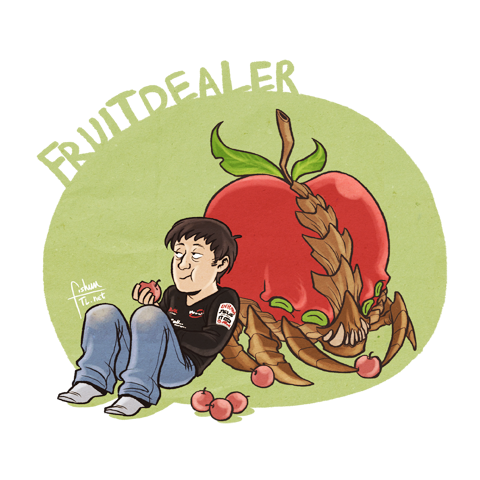
Art by fishuu
Old soldiers don't die, they just fade away.
Thanks to Plexa, motbob, SirJolt, Probe1, Heyoka, and shiroiusagi. With out them this article would have been a blog rather than a FE.
![[image loading]](/staff/shiroiusagi/fruitdealer/navbar/gambler.png)
![[image loading]](/staff/shiroiusagi/fruitdealer/navbar/spacedot.png)
![[image loading]](/staff/shiroiusagi/fruitdealer/navbar/scholar.png)
![[image loading]](/staff/shiroiusagi/fruitdealer/navbar/innovator.png)
![[image loading]](/staff/shiroiusagi/fruitdealer/navbar/warrior.png)
![[image loading]](/staff/shiroiusagi/fruitdealer/navbar/tragic.png)
![[image loading]](/staff/shiroiusagi/fruitdealer/navbar/liquipedia.png)
![[image loading]](/staff/shiroiusagi/fruitdealer/fd_01image.jpg)
![[image loading]](/staff/shiroiusagi/fruitdealer/fd_05image.jpg)
![[image loading]](/staff/shiroiusagi/fruitdealer/fd_11image.png)
![[image loading]](/staff/shiroiusagi/fruitdealer/fd_22image.jpg)


![[image loading]](http://upload.wikimedia.org/wikipedia/commons/thumb/a/a2/Soju_jinro_gfdl.jpg/150px-Soju_jinro_gfdl.jpg)

